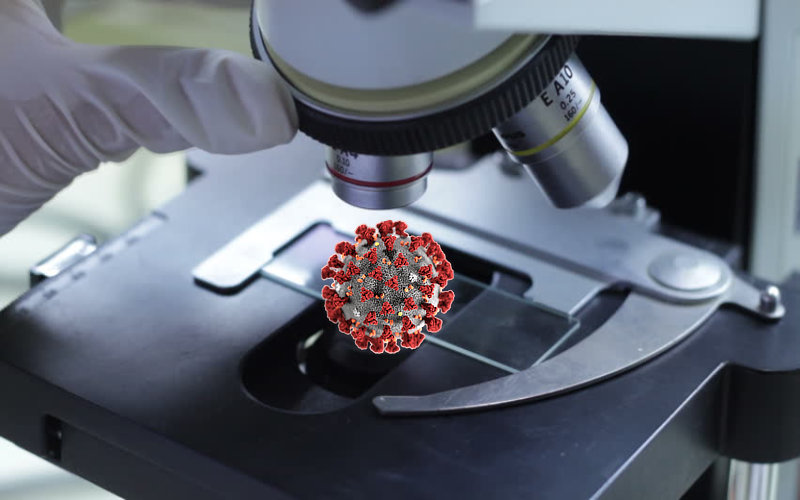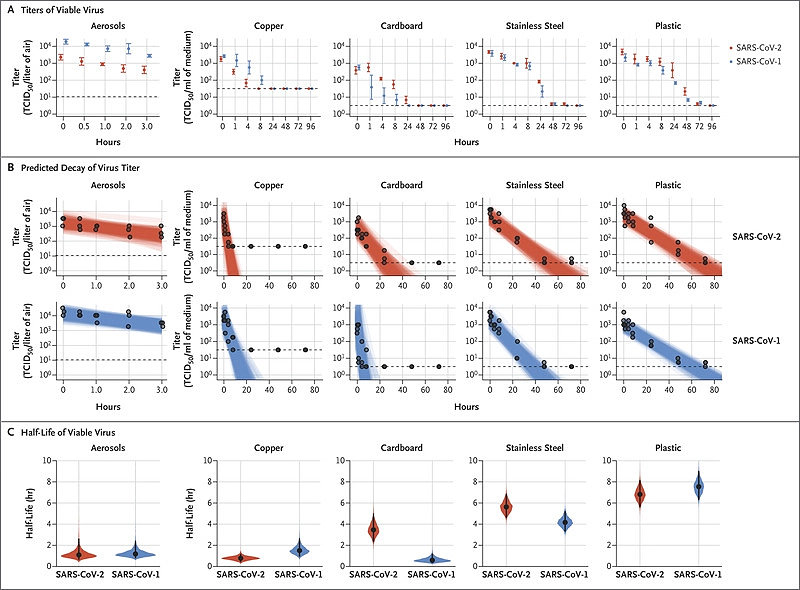How Long COVID-19 Coronavirus Stays on Surfaces | UPDATED

It is logical and sensible to ask this question. How long does coronavirus (covid-19) live / survive on surfaces?
(UPDATED INFORMATION BELOW)
Why? Because one best way to avoid getting it, is to… avoid it! And “it” is not just other people who might be contagious. “It” could be on the surfaces of things that infected people touch or handle. At least for awhile, until it dies-off.
How long does it take for coronavirus to die on surfaces?
Evidently, much longer than ordinary flu virus! Which is why I’m posting this information.
I searched the internet for seemingly qualified or authoritative sites for this data. You can do the same. This is generally what I found.
( jump to updated specific information below )
Average 4 – 5 Days | Up to 9 Days
The team has found the novel coronavirus can stay up to nine days on common surfaces, based on their comprehensive analysis of studies about similar pathogens, such as the SARS coronavirus and MERS-CoV.
~ News Medical Life Sciences via Journal of Hospital Infection
The results show that the viruses can persist or survive on surfaces and remain infectious at room temperature for nine days, with an average lifespan of four to five days.
It can persist on inanimate surfaces like metal, glass or plastic for up to 9 days,
source:
Persistence of coronavirus on inanimate surfaces
There is not a lot of data on this new virus (covid-19). Yet. The best we can do is take common sense precautions and actions to minimize exposure.
Published in The New England Journal of Medicine (mid-March)
Aerosol and Surface Stability of SARS-CoV-2 (COVID-19)
The tests evaluated the stability of SARS-CoV-2 and SARS-CoV-1 in aerosols and on various surfaces and estimated their decay rates.

( source: nejm.org )
AEROSOLS
“SARS-CoV-2 remained viable in aerosols throughout the duration of our experiment (3 hours), with a reduction in infectious titer from 103.5 to 102.7 TCID50 per liter of air.”
In other words, still seemingly significantly infectious (in their test environment). Applying this to real world conditions? Certainly concerning within a enclosed environment such as a grocery store (__ fill in the blank). A cough from a infected person will release aerosols which may significantly linger.
CARDBOARD
COVID-19 on cardboard appears to reduce to insignificance by about 40 hours. Say, 2 days. Significant apparent reduction after 24 hours, but pretty safe to say 48 hours for assurance based on the graph presented above.
Real world concerns may include cardboard boxes you may receive in the mail. Amazon (for example). But only if that box got contaminated somehow.
PLASTIC
This virus on plastic remained the longest of that which they tested. Looks like about 90 hours, or about 4 days.
Concerns might include any product in stores which have plastic wrapping / containment. Maybe shopping carts and/or their handles. Again, it would only be an issue if it’s contaminated with this virus (a infected person coughing on it or perhaps handling it).
Stainless Steel
Apparently up to 80 hours until limit of detection. 3 to 4 days.
Real world? Door handles, railings, anything made of steel. Shopping carts.
END OF UPDATE
PREVIOUSLY PUBLISHED ARTICLE CONTINUES BELOW (MAR-2),
The reason I’m writing about this (how long coronavirus can live on surfaces) is this:
Can my mail, packages, products, groceries be contaminated with coronavirus?
Should we be concerned about this?
Of course we should! Especially if this virus becomes a big problem where you live.
When COVID-19 coronavirus becomes prevalent in a given area, surfaces among public (and private) places will become contaminated with virus to an extent.
The exceptionally long period of time (for this virus) of contagion while not showing symptoms is especially concerning. 4 – 5 days, a week, and up to 2 weeks have been reported.
These factors (people who may be contagious for weeks) make it very concerning while wondering about various object surfaces. You just won’t know. It cannot be seen. Can’t smell it or detect it.
How could coronavirus get on my mail?
An infected mail carrier or handler who has not yet become symptomatic or ill enough to leave work?
Fortunately most all mail goes through mechanized sorting and automated systems. If any of you are familiar with the distribution systems of the US Postal mail system, chime in. How many humans touch the mail?
I suspect not many. Except final delivery. So your mail-person would have to be infected, not showing symptoms, and delivering your mail. Once they’re sick, they won’t be working…
What about boxes & packages from Amazon or UPS or FedEx?
Lots of Amazon products come directly from their various massive warehouses around the country – where they stock inventory. A good percentage of product also comes from 3rd-party sellers. In general, I would think that much inventory has been on the shelves at amazon warehouses for more than 9 days prior to being ordered and sent out. So in that sense, I don’t believe there’s much of a worry. Unless and until workers themselves become infectious and contaminate product…
Maybe that’s more reason to buy product (including groceries?) on amzn, rather than risking public exposure in a store?
What about infected boxes and packages from UPS or FedEx? Their infrastructure is highly automated and sorted. There are very few hands on any package. Probably only when entering the system and then when trucks are loaded out for delivery. Vulnerability only exists “if” delivery or load-out person is infected, and happens to cough or sneeze on a box or boxes.
Coronavirus at Costco? Walmart? Your Grocery Store?
Now we’re getting into it… In my view these types of places carry the most risk of catching coronavirus if it’s landed in your area.
Why? Because lots and lots of people are in and out of there. And they’re touching everything. How many of them do you believe have clean hands? Yah, that’s what I thought…
This is where the long asymptomatic contagious period of covid-19 coronavirus becomes a bigger problem. People walking around shedding virus, while they feel fine.
The products that will be more likely affected (infected?) than others will be those which get picked up more often – and put back down.
In a grocery store you’re talking produce. How many have picked up that tomato or avocado or (fill in the blank) and put it back down because it wasn’t “just right”? Lots. It’s kinda gross when you really think about it.
What’s the risk of coronavirus on all these surfaces?
My takeaway is this…
UPDATE:
It appears that COVID-19 Coronavirus may remain on surfaces in a viable / infectious state (worst case – stainless steel and plastics) up to 4 days, based on latest information. But, the risk will only exist if other infected people shed the virus onto it.
Most surfaces at risk will be in places where lots of people are in and out.
I’m not too concerned about amazon packages, UPS, FedEx deliveries. Or even the US mail. Although one might take precautions by setting aside your cardboard boxes and mail for several days before going through it. That’s what I am currently doing as of this update.
I am concerned most about grocery stores, and places like Costco, Walmart, and others, for example.
What’s potentially worse in any of these places will be the handles on the carts / carriages / baskets. USE THE DISINFECTANT WIPES THAT ALL OF THESE PLACES (SHOULD) HAVE AT THE CARRIAGE LOCATION. I do, every single time.
Then it’s the people around you. Their breathing, coughing or sneezing. If that happens next to or near you, then you are immediately at risk. Hold your breath and move away. That’s what I do. Though it may already have gotten in your eyes – then it’s too late. Done. It’s in.
The products themselves? Again, the things people pick up and put down a lot. Those are the riskiest.
Okay, that’s my initial take on the situation.
What’s your opinion?
